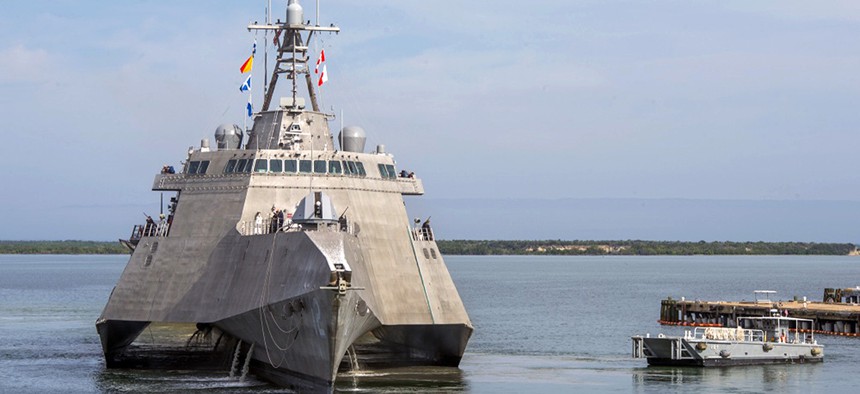The Internet of Things' Role on Battlefields and at Sea

A Naval Station vessel, right, prepares to assist the future USS Omaha (LCS 12), a 218-foot-long littoral combat ship, pier side during a brief fuel stop in Guantanamo Bay, Cuba. U.S. Navy/AP
The Army and Navy are still mapping how to bring more internet of things devices into combat domains.
The internet of things, that loose assortment of tiny sensors now embedded in seemingly everything, can collectively do a lot.
Each individual sensor isn’t capable of very much but when combined with billions of others, they can map human behavior, help to predict everything from shopping trends to the weather, and perform millions of other tasks, both mundane and critical. They are even making their way into heavily industrialized applications, and have also been hijacked and used for bad things, like the world’s largest botnet attack.
But despite their seeming hegemony and limitless potential, there are a couple places where the tiny sensors have yet to gain much of a foothold. One of them is deep in the world’s oceans, and the other is on the frontlines of today’s modern battlefield. The armed forces want to change that, with the Navy working to develop its own flotilla of seafaring IoT vessels and the Army bringing the technology to battlefields.
Both programs are advancing independently, and both face big challenges. The problem for the Navy is mostly physical, as the service know exactly what it wants, just not how to achieve it. The Army, on the other hand, only has a general idea of how IoT might perform in combat, and is still developing its program.
The Navy needs more information about what is happening in the vast stretches of ocean that encompass most of our planet. This includes everything from precise weather conditions to the passage of potential enemy vessels. The so-called Ocean of Things project envisions deploying thousands of floating IoT devices around the globe and having them report via satellite into a computer network that will track and display everything for Navy officials.
The Defense Advanced Research Projects Agency leads the program, and one solicitation for the Ocean of Things has already been made. There are two problems that DARPA is hoping that industry will help them overcome. The first is simply the harsh environment of the ocean itself. Some type of floating craft would need to be created that can survive for at least a year in the middle of nowhere and protect the IoT sensors inside. DARPA envisions the craft scuttling themselves after a year, so nothing onboard could pose an environmental hazard or a threat to ships in the area.
Then there is the challenge of the data collection network. Data from Ocean of Things sensors would need to be sent to satellites, stored in the cloud, and reassembled to show a nearly real-time status report of the entire ocean. Having lived beside a beach for a few years, where I got to experience violent ocean-based storms firsthand, I would guess that the data collection problem is small potatoes compared to creating a tiny, survivable IoT vessel fit for the high seas.
Whereas the Navy has its program fairly well-sketched out, the Army is still solidifying its vision as to how IoT could provide troops an edge in combat. To that end, the service formed the Internet of Battlefield Things Collaborative Research Alliance, and put out a solicitation in March, stating that “a joint collaborative approach by multidisciplinary researchers is required to make fundamental advances towards meeting the CRA goal to develop a fundamental understanding of IoBTs.” Funded by the Army Research Laboratory, the $25 million IoBT project is being led by the University of Illinois at Urbana-Champaign.
The Army sees IoT devices taking both a passive role in future battlefields, gathering intelligence on the enemy, and an active one, performing tasks and even possibility directing some of the fighting though under human direction.
“We don’t want to micromanage the machines and things doing the work,” Tarek Abdelzaher, a researcher on the project at the University of Illinois, told the Chicago Tribune. “I want to tell [the machines] my intent, and then I want them to have the sort of intelligence, autonomy and initiative to figure out how to meet my intent.”
If these two programs pan out, IoT devices may take on even more roles, those of soldiers and sailors. I guess it’s a good thing that at least some of them will be turning 18 around that time. It would make them old enough to enlist.
John Breeden II is an award-winning journalist and reviewer with over 20 years of experience covering technology. He is the CEO of the Tech Writers Bureau, a group that creates technological thought leadership content for organizations of all sizes. Twitter: @LabGuys






